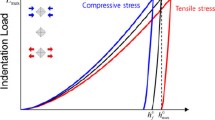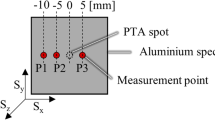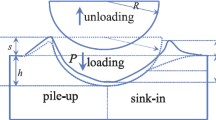Abstract
An analytical model is presented for determining surface residual stress using continuous indentation. The elastic residual stress is assumed to have no influence on contact area or hardness and to be uniform over a volume that is several times larger than the indentation mark. A step-by-step analysis for the residual-stress-induced load difference at a given depth is outlined here and such concepts as stress interaction, stress-sensitive contact morphology, and reversible contact recoveries during a stress relaxation are described. Finally, the proposed method is applied to the interpretation of the continuous indentation results obtained from an SS400 steel beam in which controlled bending stresses are generated. The stress estimated, however, showed a high scatter due to plastic pile-up deformation. When the optically measured contact area is used as an alternative of the contact area calculated from the unloading curve, the re-evaluated stress agrees well with the already known applied stress.
Similar content being viewed by others
References
Lu, J., editor, Society for Experimental Mechanics, Handbook of Measurement of Residual Stresses, Fairmont Press, Lilburn, 228–229 (1996).
Fuud, C.O., DiMascio, P.S., andYavelak, J.J., “Comparison of Three Residual-Stress Measurement Methods on a Mild Steel,” EXPERIMENTAL MECHANICS,25,338–343 (1985).
Oliver, W.C. andPharr, G.M., “An Improved Technique for Determining Hardness and Elastic Modulus Using Load and Displacement Sensing Indentation Experiments,” Journal of Materials Research,7, (6),1564–1583 (1992).
Ahn, J.H. andKwon, D., “Derivation of Plastic Stress-Strain Relationship from Ball Indentation: Examination of Strain Definition and Pileup Effect,” Journal of Materials Research,16 (11),3170–3178 (2001).
LaFontaine, W.R., Paszkiet, C.A., Korhonen, M.A. andLi, C.-Y., “Residual Stress Measurements of Thin Aluminum Metallizations by Continuous Indentation and X-ray Stress Measurement Techniques,” Journal of Materials Research,6, (10),2084–2090 (1991).
Tsui, T.Y., Oliver, W.C., andPharr, G.M., “Influences of Stress on the Measurement of Mechanical Properties Using Nanoindentation: Part 1. Experimental Studies in an Aluminum Alloy,” Journal of Materials Research,11 (3),752–759 (1996).
Lee, Y.-H. andKwon, D., “Residual Stresses in DLC/Si and Au/Si Systems: Application of a Stress-Relaxation Model to the Nanoindentation Technique,” Journal of Materials Research,17, (4),901–907 (2002).
Johnson, K.L., Contact Mechanics, 1st edition, Cambridge University Press, Cambridge, 171 (1985).
Frenkel, J., Abbate, A. andScholz, W., “The Effect of Residual Stresses on Hardness Measurements,” EXPERIMENTAL MECHANICS,33,164–168 (1993).
Bolshakov, A., Oliver, W.C., andPharr, G.M., “Influences of Stress on the Measurement of Mechanical Properties Using Nanoindentation: Part II. Finite Element Simulations,” Journal of Materials Research,11 (3),760–768 (1996).
Mencik, J. andSwain, M.V., “Micro-indentation Tests with Pointed Indenters,” Materials Forum,18,277–288 (1994).
Hainsworth, S.V., Chandler, H.W., andPage, T.F., “Analysis of Nanoindentation Load-Displacement Loading Curves,” Journal of Materials Research,11 (8),1987–1995 (1996).
Underwood, J.H., “Residual-Stress Measurement Using Surface Displacements around an Indentation,” EXPERIMENTAL MECHANICS,13,373–380 (1973).
Olabi, A.G. andHashmi, M.S.J., “Stress Relief Procedures for Low Carbon Steel (1020) Welded Components,” Journal of Material Processing Technology,56,552–562 (1996).
Author information
Authors and Affiliations
Rights and permissions
About this article
Cite this article
Lee, Y.H., Ji, W.j. & Kwon, D. Stress measurement of SS400 steel beam using the continuous indentation technique. Experimental Mechanics 44, 55–61 (2004). https://doi.org/10.1007/BF02427977
Received:
Accepted:
Issue Date:
DOI: https://doi.org/10.1007/BF02427977




